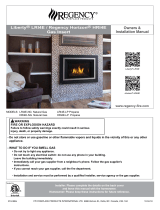
E33-10 FPI Direct Vent Gas Insert | 13
| 13
installation
2) Installation and repair should be done by
a qualied service person.
3) The appliance should be inspected before use
and at least annually by a professional service
person. More frequent cleaning may be required
due to excessive lint from carpeting, bedding
material, animal hair, etc. It is imperative that
control compartments, burners and circulating
air passageways of the appliance be kept clean.
4) See general construction and assembly
instructions. This appliance may only be
installed in a vented, noncombustible replace.
5) This appliance is Listed for bedroom installations
when used with a Listed Millivolt Thermostat.
Some areas may have further requirements,
check local codes before installation.
6) Always connect this insert to a vent system
venting to the outside of the building envelope.
Never vent to another room or inside a building.
Make sure that the vent is properly sized and is
of adequate height to provide the proper draft.
7) Inspect the venting system annually for
blockage and any signs of deterioration.
8) Any glass removed for servicing must be
replaced prior to operating the appliance.
9) To prevent injury, do not allow anyone who
is unfamiliar with the operation to use the
replace.
10) Due to high temperatures, the appliance should
be located out of high trac areas and away
from furniture and draperies. Children and
adults should be alerted to the hazards of high
surface temperatures, especially the replace
glass and gold trims, and should stay away to
avoid burns or clothing ignition. Young children
should be carefully supervised when they are
in the same room as the appliance. Clothing or
other ammable material should not be placed
on or near the appliance.
IMPORTANT MESSAGE
SAVE THESE
INSTRUCTIONS
The Regency Gas Insert must be installed in
accordance with these instructions. Carefully read
all the instructions in this manual rst. Consult the
building authority having jurisdiction to determine
the need for a permit prior to starting the installation.
NOTE: Failure to follow the instructions could
cause a malfunction of the heater which could
result in death, serious bodily injury, and/or property
damage. Failure to follow these instructions may
also void your re insurance and/or warranty.
FOR YOUR SAFETY
This appliance requires air for proper combustion.
Always provide adequate combustion and ventilation
air. Follow instructions and information in CSA
B149.1 (in Canada) or the National Fuel Gas Code
ANSI Z223.1 (in the USA), regarding requirements
for combustion and ventilation air.
CLOTHING OR OTHER FLAMMABLE
MATERIAL SHOULD NOT BE PLACED
ON OR NEAR THE APPLIANCE.
CHILDREN AND ADULTS SHOULD
BE ALERTED TO THE HAZARDS OF
HIGH SURFACE TEMPERATURES,
ESPECIALLY THE FIREPLACE GLASS,
AND SHOULD STAY AWAY TO AVOID
BURNS OR CLOTHING IGNITION.
INSTALLATION AND REPAIR SHOULD
BE DONE BY AN AUTHORIZED
SERVICE PERSON. THE APPLIANCE
SHOULD BE INSPECTED BEFORE
USE AND AT LEAST ANNUALLY BY A
PROFESSIONAL SERVICE PERSON.
MORE FREQUENT CLEANING MAY
BE REQUIRED DUE TO EXCESSIVE
LINT FROM CARPETING, BEDDING
MATERIAL, ETC. IT IS IMPERATIVE
THAT CONTROL COMPARTMENTS,
BURNERS AND CIRCULATING AIR
PASSAGEWAYS OF THE APPLIANCE
BE KEPT CLEAN.
DUE TO HIGH TEMPERATURES, THE
APPLIANCE SHOULD BE LOCATED
OUT OF TRAFFIC AND AWAY FROM
FURNITURE AND DRAPERIES.
WARNING: FAILURE TO INSTALL THIS
APPLIANCE CORRECTLY WILL VOID
YOUR WARRANTY AND MAY CAUSE
A SERIOUS HOUSE FIRE.
YOUNG CHILDREN SHOULD BE
CAREFULLY SUPERVISED WHEN
THEY ARE IN THE SAME AREA
AS THE APPLIANCE. TODDLERS,
YOUNG CHILDREN AND OTHERS MAY
BE SUSCEPTIBLE TO ACCIDENTAL
CONTACT BURNS. A PHYSICAL
BARRIERS IS RECOMMENDED IF
THERE ARE AT RISK INDIVIDUAL IN
THE HOUSE. TO RESTRICT ACCESS TO
A FIREPLACE OR STOVE, INSTALL AN
ADJUSTABLE SAFETY GATE TO KEEP
TODDLERS, YOUNG CHILDREN AND
OTHER AT RISK INDIVIDUALS OUT
OF THE ROOM AND AWAY FROM HOT
SURFACES.
BEFORE YOU START
Safe installation and operation of this appliance re-
quires common sense, however, we are required by
the Canadian Safety Standards and ANSI Standards
to make you aware of the following:
General Safety Information
1) The appliance installation must conform with
local codes or in the absence of local codes,
with CSA B149.1 (in Canada) or the National
Fuel Gas Code ANSI Z223.1 in the U.S.A. This
appliance should be installed by a qualied gas
tter technician only.
A BARRIER DESIGNED TO REDUCE
THE RISK OF BURNS FROM THE HOT
VIEWING GLASS IS PROVIDED WITH
THIS APPLIANCE AND SHALL BE
INSTALLED FOR THE PROTECTION
OF CHILDREN AND OTHER AT-RISK
INDIVIDUALS.
IF THE BARRIER BECOMES DAMAGED,
THE BARRIER SHALL BE REPLACED
WITH THE MANUFACTURER'S
BARRIER FOR THIS APPLIANCE.
ANY SAFETY SCREEN, GUARD,
OR BARRIER REMOVED FOR
SERVICING AN APPLIANCE MUST
BE REPLACED PRIOR TO OPERATING
THE APPLIANCE.
For the State of Massachusetts, installation
and repair must be done by a plumber or
gastter licensed in the Commonwealth of
Massachusetts.
For the State of Massachusetts, exible con-
nectors shall not exceed 36 inches in length.
For the State of Massachusetts, the appliances
individual manual shut-o must be a t-handle
type valve.
The State of Massachusetts requires the
installation of a carbon monoxide alarm in
accordance with NFPA 720 and a CO alarm
with battery back up in the same room where
the gas appliance is installed.



































